How to Calculate the Value of Pearls?

According to the GIA, you can calculate the value of a pearl by considering its size, luster, shape, color, and surface quality.
And for pearl jewelry with more than one pearl, you also consider the matching.
Factors that determine the value of pearls

It’s not enough to know the factors; it’s equally essential to understand how those factors affect pearl value. Here are the details.
Wild and natural pearls vs. cultured pearls

Natural pearls are rare because divers need to find them from oysters in the sea, while pearl farmers grow cultured pearls in saltwater or freshwater.
So, natural pearls are rare and more difficult to find, which makes them more valuable than cultured pearls.
A natural pearl once sold for around $7m in 2007, and a few have sold for more than that.
Cultured pearls do not cost that much. Typically, you find them around $50 to anything around $200,000.
Size: Size can also determine pearl value. If all the other factors are similar, more oversized pearls would typically have more value for the same pearl type.
Most pearl jewelry is usually in the 3mm to 18mm range. Some pearls tend to be small or large, depending on their type.
For instance, Akoya pearls are typically small and less than 10mm, while South Sea pearls are usually large.
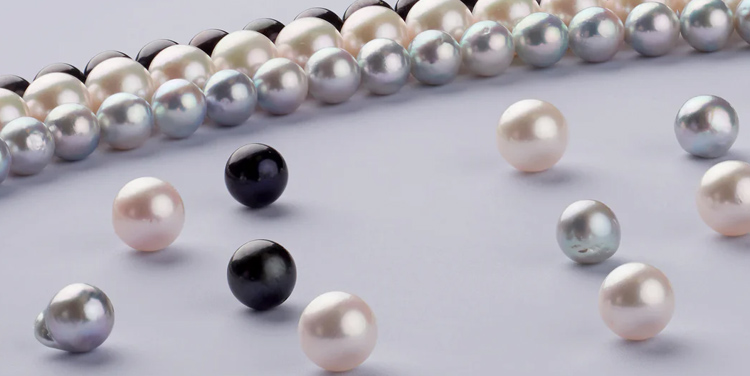
Shape: Pearls come in various shapes, like round, semi-round, button, drop, circle, and baroque.
Unsurprisingly, rounder pearls have more value than the other shapes.
However, there is an exception for free-formed baroque pearls due to their uniqueness.

Color: Valuing pearls by color is more nuanced as you consider body color, overtone, and the Orient.
Color is more critical in grading some pearls than others.
For instance, White South Sea pearls usually cost less than golden South Sea pearls.
For Tahitian pearls, the most valuable color is the peacock green.
Akoya pearls with unprocessed white and pink overtone cost more than other colors.
Metallic freshwater pearls have more value than other freshwater pearl colors.
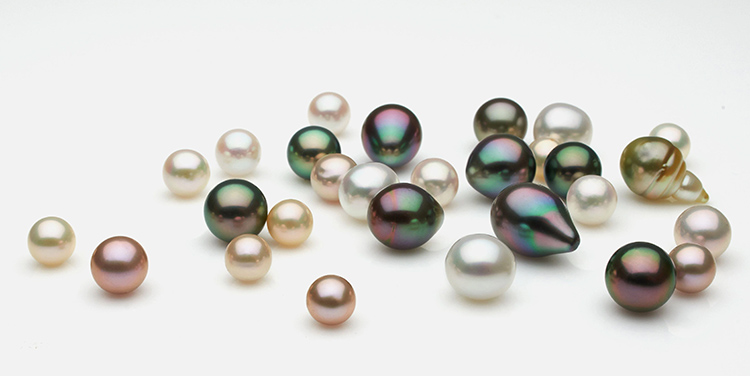
Luster: Luster is a pearl’s shiny qualities, produced by built-up layers of nacre.
The value of pearls increases as their reflection gets clearer.
Pearls with mirror-like reflections have more value than those with dull reflections.

Nacre: Nacre is the secreted layers from the oysters that form around the foreign object that triggers the pearl formation.
Nacre is directly related to luster quality and pearl durability.
Pearls with thicker layers usually have a shinier and brighter luster, costing more than those with thinner nacre.

Surface: It is not surprising that the surface of a pearl can determine its value.
The smoother the surface of a pearl, the more valuable it is.
Although pearls cannot be 100% flawless, the highest quality ones will not have blemishes that you can see clearly.

Value by grade of pearls
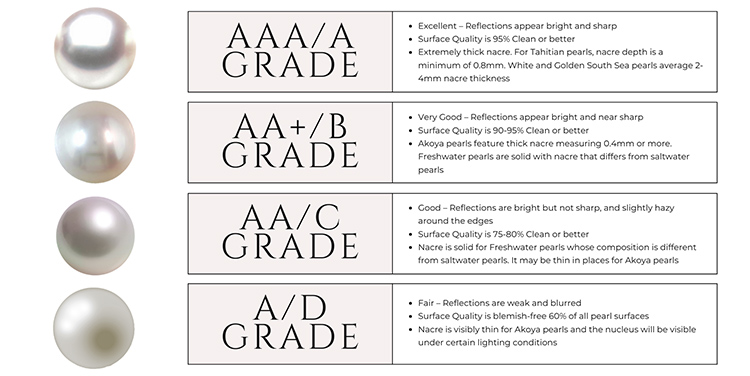
AAA Grade / A Grade: Pearls of this grade are 95% and above clean on the surface, with very high to excellent luster and easily recognizable reflections on the surface.
Pearls should also be blemish-free, clean on both sides for earrings, and have little differences in terms of matching.

AA+ Grade / B Grade: This pearl grade usually has 90-95% surface quality with high to very sharp luster quality.
They will have a thick nacre as well. For instance, Akoyas of this grade will have a nacre of around 0.4mm or more.
There may be slight blurring, but nothing significant. Pearl jewelry of this grade should be blemish-free.
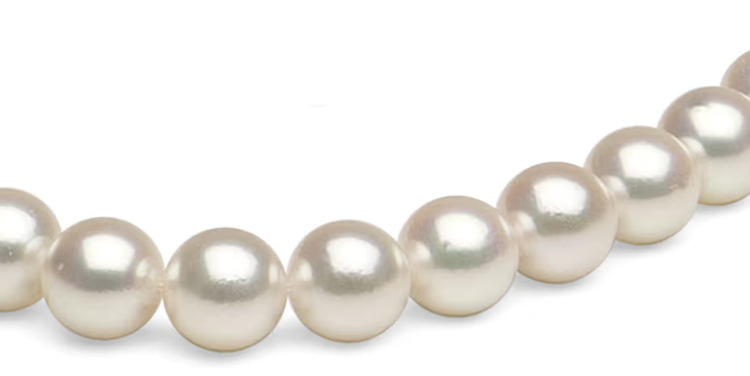
AA Quality / C Grade: The surface quality for this grade is around 75-80%, and sometimes better.
Solid nacre is the standard for freshwater pearls and slightly thinner for Akoya pearls.
Luster is good to high, with somewhat blurry reflections.
Pearl jewelry will have minor blemishes in and around the surface area of the pearl.

A Quality / D Grade: This is the lowest value of pearls by grading.
Freshwater pearls will have solid nacre, while Akoyas will have thin ones. Luster is fair to sound; you can see blurry reflections.
There are also noticeable marks and blemishes in and around the surface area.

Value by types of pearls

●South Sea pearls: They are typically the largest and most valuable in the market.
Depending on the color and size, a strand can cost somewhere from $1,000 to over $160,000.
As stated, golden-colored ones are more valuable.
●Tahitian Pearls: Tahitian pearls have a quintessential dark color that gives them an exotic appearance.
You can find Tahitian pearls for anything between $500 to more than $25,000, depending on size and quality.
●Akoya Pearls: Akoya pearls are classic pearls, round and white.
They tend to be smaller than the other types.
A strand of Akoya pearl will set you back by $300 to around $10,000.
●Freshwater pearls: They are versatile and can look like Akoya pearls due to their shapes and size.
But they are less expensive, costing between $50 to $2,000.
Other factors that impact the value of pearls

Aside from the stated factors like type and appearance factors, other factors can also determine the value of pearls.
●Brands: High-end and luxury brands like Coco Chanel, Mikimoto, and Tifanny & Co. typically sell pearls at higher prices than elsewhere.
●Style: The style of jewelry also impacts its value. For the same type of pearls, collar-style necklaces typically cost more than chokers or matinees.
Meanwhile, 70-85 cm long opera-style pearl jewelry can cost as much as collar-style.
For earrings, chandelier styles usually have a higher value than stud earrings. So, style does impact the value of pearls.
●Gemstones/Metals: The matching gemstones paired with pearl jewelry can also impact its value.
For instance, gold or diamond jewelry with pearls will cost more than sterling silver with the same type of pearl.
Rubies, sapphires, turquoise, and diamonds all have different values, which impact the value of the pearl.
Where to buy affordable Pearls?

If you are looking for affordable pearls, there are better places to look than Tiffany & Co. and Mikimoto.
There are several other online brand stores where you can find genuine, high-quality, and well-priced pearls.
Whitevictoria: Are you looking for different styles and types of pearls to buy at reasonable prices?
As a brand of over 20 years, you can find high-quality pearls in the Whitevictoria online shop.
You also enjoy excellent customer service, free shipping, and a 60-day return policy.
And that’s not all. There’s also an ongoing site-wide 15% discount for the Christmas season.

The pearl source: The pearl source is a family-owned pearl brand with over 50 years of market presence.
You can also head to their online store to find high-quality pearls at reasonable and affordable prices.

Olivia and Pearl: Olivia and Pearl is a London-based pearl brand offering various styles of high-quality and affordable pearl jewelry.
Aside from offering reasonable prices, you also get an extended 60-day return period, gift wrapping, and next-day shipping.

You can also find affordable pearls from online stores on Amazon, but shopping for pearls in such places could be tricky as quality control is not as strong as it will be for reputable pearl brands.
Conclusion

Understanding pearl pricing requires careful study of the characteristics, type, grade, and even the brand of the pearl.
But the most important thing when buying pearls is ensuring they are genuine. Here is how to identify real pearls.
Once you are sure they are genuine, look for the type and style of your choice and consider their appearance.
And if you need affordable pearls, Whitevictoria is the best place for you.


+K1019-1-700x700.jpg)
+K1019-2-700x700.jpg)
+K1003+L1008-1-700x700.jpg)
+K1003+L1008-2-700x700.jpg)
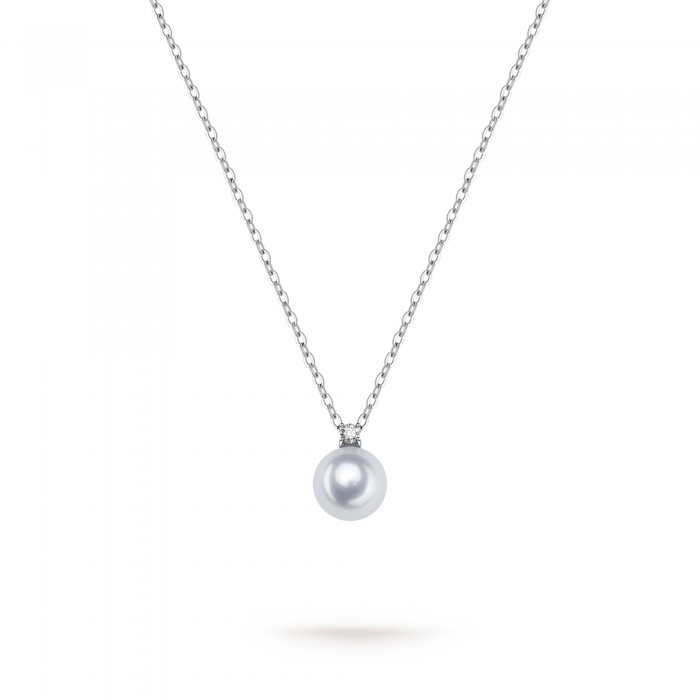

1 Comment(s)
I found a pearl in a crawfish is it of value. 1pearl in two pieces but they fit as 1
Leave a Comment